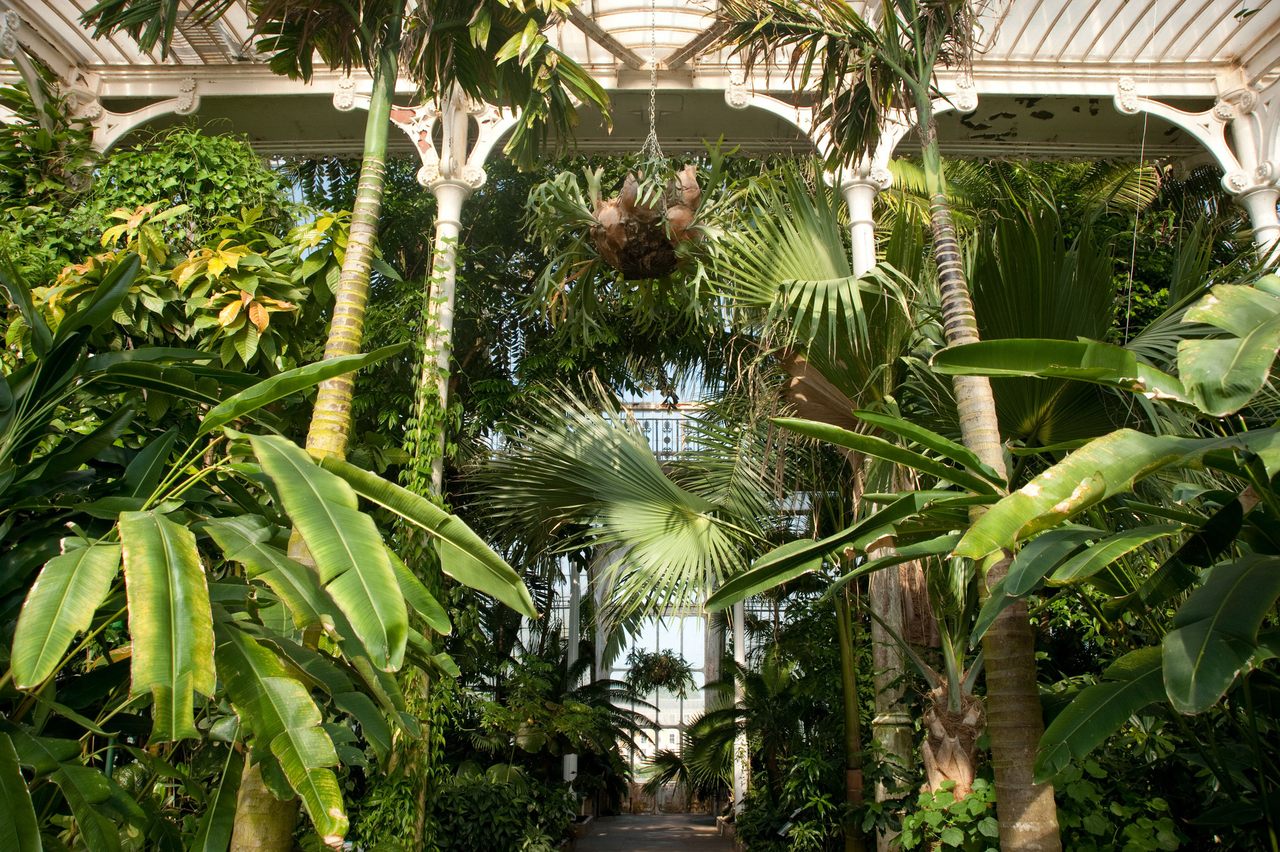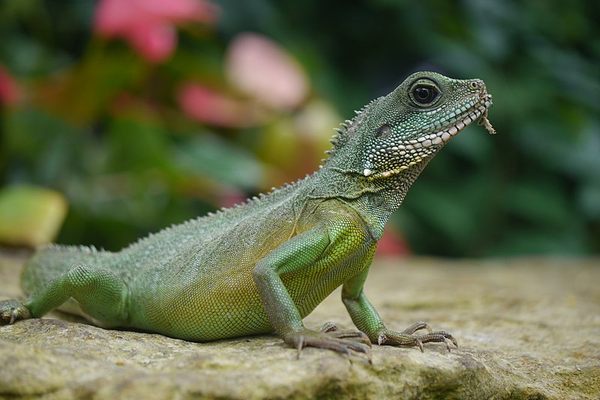Kew Gardens Is Undergoing a Big, Steamy Change
Fitted PJs, new glasses, and a good drilling will keep this Victorian icon hot.
Just off the Thames in Southwest London, a prehistoric type of South African palm tree has been living for almost two centuries. Growing an inch a year, today it’s the height of a double-decker bus and slopes drunkenly 16 feet to the side. It needs four metal crutches to keep from falling over altogether—for an expat at least 249 years old, not bad.
The tree, an Eastern Cape giant cycad, is kept in the Palm House at the Royal Botanic Gardens of Kew—an enormous, Victorian glass greenhouse and steamy Noah’s Ark for endangered species. The giant cycad is surrounded by tropical plants, from a solitary, silver-blue madagascan palm to vines heavy with yams, and rare island species thought extinct in the wild.
But now Kew Gardens is facing a thorny problem. More often these days, the cycad is also surrounded by Will Spoelstra and his team of horticulturalists, tinkering with the soil in T-shirts and Wellington boots while engineers set up heat tracing equipment and, far beneath plants and people, contractors drill holes hundreds of meters into the ground.

After so many years, the giant cycad’s home is preparing for a nail-biting renovation, and many of the plants have to be moved—but with ancient organisms, nothing happens quickly.
“They do have to kind of prep them,” says Tara Munday, Kew’s senior spokesperson. “Make them used to being fiddled with.” Spoelstra digs down around each plant to consolidate the ball of roots at its base (creatively: it’s “root ball”) for a full year, before the plant can be lifted without damage. “I’m not sure the plants are dead happy about being moved,” Munday adds.
In the slow-motion commotion to come, however, not all plants will be so lucky. Some will be propagated and others, a few bad specimens, chucked out all together.
The Eastern Cape giant cycad needn’t worry—it is a Palm House centerpiece and doesn’t need fiddling. With a root ball five by five feet, the giant cycad is, in fact, the largest potted plant in the world, gardeners say, and the oldest. It’s been in a pot since it arrived from South Africa by boat in 1775, when what are now the Royal Botanic Gardens were the much smaller private amusement of Princess Augusta. The history and age of the building are part of the problem today.

The cycad arrived at the cusp of a craze for tropical plants in royal European gardens. First, it was stored in a lean-to heated by an open fire with less than a dozen other palm species. Soon—via consuls, colonizers, and a lively market for biopiracy—10 different greenhouses were overflowing across the gardens. From places like Venezuela and Australia, plants arrived faster than they could be kept alive. By the 1840s, the number of orchid species had blossomed over a hundred, only to die back just as quickly to only 15.
The problem back then was that no one greenhouse could get “the essential requirements of temperature, humidity and ventilation” right, wrote the gardens’ former chief archivist, Ray Desmond, “and losses were consequently high.” In 1844, to solve the problem, British parliament granted £5,000 (just over $1 million today) for the first flagship project of an expanded, newly nationalized Kew: a “noble palm house.” The only question was how to build it.
In the time since palms started arriving at Kew, greenhouses had grown more sophisticated. So when the Irish engineer Richard Turner was asked to come up with a design, it only took him a fortnight. Still, at 200 feet long, the then-largest greenhouse in the world required some innovation.

Borrowing techniques from ship-building, Turner determined wrought iron would be strong enough to hold up the building’s skeleton without a central pillar. Instead of an open fire, 12 underground boilers could warm water through grates underneath the plants, with a tunnel to carry coal in and chuff smoke out of a chimney 180 yards away, disguised as an Italian bell tower.
Within a decade of its completion, the Palm House was a shockingly successful oasis. Vines ran up the steelwork; plants which had never blossomed in Europe opened their buds to the steamy artificial warmth. Soon palms had to be cut back (not for the last time) before they shattered through the ceiling. Not everything went smoothly: The Palm House’s first set of glass was tinted pea-green with copper to shade the plants. Greenhouses across the country followed suit, but before long, London’s smog proved enough of a blind and each pane needed replacing, leaving the Palm House with a harlequin mismatch for years.
For better or worse, Kew’s Palm House was built to be an example from the beginning: “A noble structure, which if carried into complete execution, will be second to none in Europe,” wrote Kew’s director the year construction began.
But what was once state of the art is now in a state of disrepair. “It’s warm. It’s moist; it’s metal, you know,” says Richard Barley, Kew’s current director of gardens, from his office in the School of Horticulture. “It’s looking a bit down at heel at the moment.” Not least is the heating. Since they were first installed, the Palm House boilers have been replaced and now run on gas, not coal, but still burn between 600 and 700 tons of carbon dioxide a year—equivalent to over 150 people’s annual emissions.

“The really big prize” for this renovation, says Barley, is “what we can do in terms of making it sustainable,” even completely net-zero. If it works, Palm House could be an example once again, he explains, this time for greening historic buildings without losing storied fabric. Barley knows the stakes better than anyone, sitting at the desk of Kew’s first director from the 1840s, with a portrait of its first curator “keeping a benevolent eye on me” from the wall. Barley says, “If we can do it here, there’s really no excuse for anyone not to give it a go.”
The plan to make the Palm House green (bankrolled in its initial stages by the World Monument Fund) has two parts. First, make it leak as little heat as possible. Then find a new source for its—hopefully decreased—energy demand. Part two is expensive and part one is not as simple as it sounds.
“It’s a sort of model of heat loss,” says Rachel Purdon, Kew’s sustainability head. Not only does warmth ooze through 16,000 panes of glass and their every steel seam, but each visitor opening and closing a Palm House door (themselves made of glass) brings a waft of winter air with them. The Royal Greenhouses in Laeken—one of a few comparable greenhouses in the world, built in Belgium three decades later—is only open three weeks a year. Whereas over 2 million people visit Kew year round, and most visit the Palm House.
Now, a huge, multi-year undertaking is underway. Once each plant has been moved to temporary storage, renovators will start by replacing each pane of glass individually and sealing them to the metal afresh. Other quick fixes, however, were quickly ruled out. The doors cannot be made any smaller, because otherwise enormous palm trees wouldn’t fit in and out. Double panning the windows, an intuitive first step, was also nixed by heritage listing restrictions.

“There’s a lot of little, little niggles,” smiles Purdon, “but also what an opportunity!”
One option is night-time thermal blinds, a Palm-House-sized set of motorized pajamas to extend across the glass each evening, trapping heat. Shades were part of an original proposal during construction in the 1840s, but it was concluded the Palm House was too big. Now, electric blinds are used in commercial greenhouses across France and the south of England. “But they tend to be significantly less curvaceous,” says Purdon, “and more functional looking.”
Pending the results of ongoing test drilling, the new, green Palm House will hopefully be warmed by geothermal energy, pumping water through deep boreholes nearby in the gardens through the Palm House. Purdon doesn’t know exactly how it’ll work yet, but knows it is worth a try. “This is the first point in history where such a thing has even really been possible,” she says. She also knows there is no room for trial and error when many of the Palm House’s species are critically endangered, some thought extinct in the wild.
A degree of plant whispering has also grown around the old heating system, which the new project puts in jeopardy. “The horticulture team might know that there’s a particularly odd, cold, damp patch in that corner, or from whatever quirk of the current misting system, there’s a hot patch over here, and this type of specimen thrives,” she says. “We’re dealing with trying to create a rainforest environment in London. There’s all sorts that’s very odd about that.”

It is not lost on Barley that an English collection of tropical plants is a little odd in the first place. Ultimately, the Palm House collection is not just a reflection of Britain’s colonization, but the building historically played a significant role in enabling it, encouraging an economic botany that often paraded material extraction as research, according to archivist Desmond. As Kew tries to disentangle its colonial history while still running offices and research programs in Madagascar and Ethiopia, Barley says there is an opportunity to “refocus” the narratives running through the Palm House. New cards will be made with plants’ original names and what they meant, economically or otherwise, to the communities which first lived with them. “It sounds subtle, but it’s a fairly significant step away from the approach over the past 50 or 100 years,” says Barley.
With so much change, one thing which Kew cannot lose is the Palm House’s feeling, says Barley. “Walking into the center of the Palm House is a very visceral thing, the steamy sort of tropical-ness of it, the heat and the humidity,” he continues. By August the year it opened, Queen Victoria herself had visited the Palm House three times.
“In 1848, if you think of the people of London, they weren’t jumping on holiday jets. To go to something tropical was just mind blowing for them,” says Barley. “I think people still get that feeling when they go in there.”



















Follow us on Twitter to get the latest on the world's hidden wonders.
Like us on Facebook to get the latest on the world's hidden wonders.
Follow us on Twitter Like us on Facebook